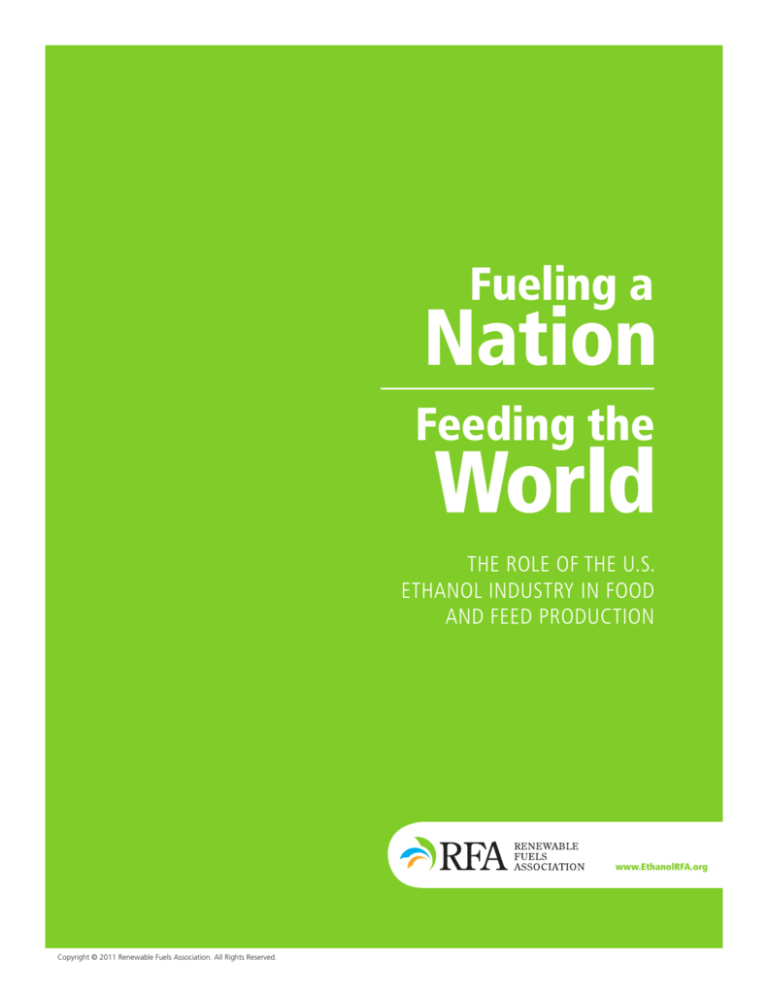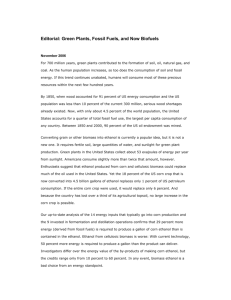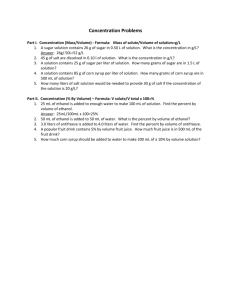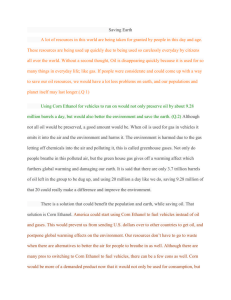
Fueling a
Nation
Feeding the
World
THE ROLE OF THE U.S.
ETHANOL INDUSTRY IN FOOD
AND FEED PRODUCTION
www.EthanolRFA.org
Copyright © 2011 Renewable Fuels Association. All Rights Reserved.
The rapid expansion of U.S. ethanol production—and the corresponding increase in the amount of
grain processed by the industry—has been well documented and scrutinized in recent years. But what
is often overlooked is the simultaneous increase in the amount of nutritious animal feed produced
by the U.S. ethanol industry. One-third of every bushel of grain that enters the ethanol process is
enhanced and returned to the animal feed market, most often in the form of distillers grains, corn
gluten feed and corn gluten meal. These co-products are fed to beef cattle, dairy cows, swine, poultry,
and fish in nations around the world.
Public debates and mainstream media reports about the grain ethanol industry often fail to fully
appreciate the scale and contribution of today’s ethanol feed co-product output. In the past decade,
the annual volume of animal feed produced by the ethanol industry has grown by a factor of eight. In
the 2009/10 marketing year1, the U.S. ethanol industry generated approximately 35 million metric
tons (mmt) of high-quality feed, making the renewable fuels sector one of the larger feed processing
segments in the United States. Grain ethanol co-product volumes are expected to approach 39 mmt in
2010/11, the current marketing year.
To put these production volumes in context, consider that the amount of feed produced by the ethanol
industry in 2009/10 is more than the total amount of grain consumed by all of the beef cattle in the
nation’s feedlots.2 Looked at another way, the amount of
The feed produced by ethanol plants in
2010/11 would be enough to produce nearly
50 billion quarter-pound hamburgers…
feed produced by the ethanol industry in 2010/11 would
rank as the world’s fourth-largest corn crop, trailing only
the United States, China, and Brazil.3 The feed produced
by ethanol plants in 2010/11 would be enough to produce
nearly 50 billion quarter-pound hamburger patties—or seven
patties for every person on the planet. Similarly, this amount of feed would produce enough chicken
for every American to eat one normal-sized chicken breast every day for one year.
By economically displacing traditional feed ingredients, ethanol co-products effectively reduce the
livestock and poultry industry’s demand for corn and protein meal. The return of co-products to
the feed market has agricultural land use implications as well (i.e. at least one-third of every acre
“dedicated” to ethanol production should actually be characterized as producing feed, not fuel).
Feed co-products represent an increasingly important share of profit opportunities for ethanol
producers. The estimated market value of feed co-products from ethanol production in 2009/10 was
$3.8 billion.4 An estimated additional $1 billion was realized through sales of corn oil, a high value coproduct of the wet mill ethanol process and some dry milling processes.
Without a doubt, co-products from grain ethanol production are an increasingly important and
valuable component of the biofuels sector and the global feed market. Not only is the U.S. ethanol
industry well positioned to provide increasing amounts of renewable fuels in the years ahead, but the
sector is also poised to help satisfy growing world demand for food and feed.
September 1, 2009 through August 31, 2010.
USDA Feed Grains Database.
USDA World Agricultural Supply and Demand Estimates. April 2011.
4
Assumes 09/10 average values per short ton of $116 for DDG and DDGS, $75 for CGF, $520 for CGM (USDA Feed Grains Database); and $45/metric ton for WDGS.
1
2
3
Copyright © 2011 Renewable Fuels Association. All Rights Reserved.
2
WHAT TYPES OF FEED DOES THE U.S. ETHANOL INDUSTRY PRODUCE?
Two processes are primarily used to make ethanol in the United States: dry milling and wet milling.
In the dry milling process, the entire corn kernel or other starchy grain is ground into flour (or “meal”)
and processed without separation of the various nutritional component parts of the grain. The meal
is slurried with water to form a “mash.” Enzymes are added to the mash, which is then processed
in a high-temperature cooker, cooled and transferred to fermenters where yeast is added and the
conversion of sugar to ethanol begins.
After fermentation, the resulting “beer” is transferred to distillation columns where the ethanol is
separated from the remaining “stillage.” The stillage is sent through a centrifuge that separates the
solids from the liquids. The liquids, or solubles, are then concentrated to about 30 percent solids by
evaporation, resulting in condensed distillers solubles (CDS) or “syrup.” CDS is sometimes sold
into the feed market, but more often the residual coarse grain solids and the CDS are mixed together
and dried to produce distillers dried grains with solubles (DDGS). In the cases where the CDS is
not reapplied to the residual grains, the product is simply called distillers dried grains (DDG). If the
distillers grains are being fed to livestock in close proximity to the ethanol plant, the drying step can be
avoided and the product is called wet distillers grains (WDG). Because of various drying and syrup
applications practices, there are several variants of distillers grains (one of which is called modified
wet distillers grains), but most product is sold as DDGS, DDG, or WDG.
DRY MILL ETHANOL PROCESS
Grain Receiving and Storage
Milling
Dried Distillers Grains
Distillers Grains
to Livestock
and Poultry
Dryer
Cooking
Liquification
CO2
Bottling,
Dry Ice and
Other Uses
Syrup Tank
Evaporator
Fermentation
Liquids
Centrifuge
Distillers
Grains to
Market
Wet Distillers Grains
Distillation
Solids
Denaturant
Ethanol to Market
Ethanol-blended Gasoline
to Consumer
Ethanol Storage
Molecular Sieve
Source: Renewable Fuels Association
3
Copyright © 2011 Renewable Fuels Association. All Rights Reserved.
Increasingly, dry mill ethanol plants are removing crude corn oil from the stillage on the back end of
the process. An estimated one-fourth to one-third of existing dry mills have the capability to extract
corn oil, which is then sold as an individual feed ingredient or as a feedstock for biodiesel production.
A handful of dry mill plants also have the capacity to fractionate the corn kernel on the front end of
the process, resulting in the production of corn germ, corn bran, “high-protein DDGS” and other
value-added products. Approximately 90% of the ethanol produced today comes from the dry milling
process.
In the wet milling process, the grain is soaked or “steeped” in water to facilitate the separation of
the grain into its basic nutritional components. After steeping, the corn slurry is processed through a
series of grinders to separate the corn germ. Corn oil from the germ is either extracted on-site or sold
to crushers who extract the corn oil. The remaining fiber, gluten and starch components are further
segregated. The steeping liquor is concentrated in an evaporator. This concentrated product, heavy
steep water, is co-dried with the fiber component and is then sold as corn gluten feed (CGF). The
gluten component is filtered and dried to produce the corn gluten meal (CGM), a high-protein
product used primarily as feed in poultry operations. The remaining starch can then be processed in
one of three ways: fermented into ethanol, dried or modified corn starch, or processed into corn syrup.
Co-Products from the U.S. Grain Ethanol Industry
Dry Mill Process
Wet Mill Process
Distillers Dried Grains with Solubles (DDGS)
Corn Gluten Feed (CGF)
Distillers Dried Grains (DDG)
Corn Gluten Meal (CGM)
Wet Distillers Grains (WDG)
Heavy Steep Water
Condensed Distillers Solubles (CDS)
Corn Germ Meal
Modified Wet Distillers Grains (MDG)
Crude Corn Oil
High-Protein DDGS (from fractionation)
De-Oiled or De-Fatted DDGS (from oil extraction)
Corn Germ Meal
Crude Corn Oil
Both the wet and dry mill processes utilize only the starch portion of the corn kernel for ethanol
production. The remaining protein, fat, fiber and other nutritional components remain available for use
as animal feed. In distillers grains, these remaining nutritional components from the corn kernel are
essentially concentrated by a factor of three, meaning typical distillers grains have at least three times
as much protein and fat as an equivalent amount of corn.
4
Copyright © 2011 Renewable Fuels Association. All Rights Reserved.
PROXIMATE NUTRITIONAL ANALYSIS OF NO. 2 YELLOW CORN, DDGS, CGF, CGM
% Dry Matter
% Protein
% Fat
% Fiber
Corn, Yellow No. 2
85.5
8.3
3.9
1.9
Corn Distillers Dried Grains w/ Solubles
89.3
30.8
11.1
7.4
Corn Gluten Feed
88.0
21.0
2.0
10.0
Corn Gluten Meal, 60%
90.0
60.0
2.0
2.5
Sources: NRC 1998, White & Johnson (Corn); University of Minnesota, 2009 (DDGS); Feedstuffs
Reference Issue (CGF and CGM)
HOW MUCH FEED DOES THE U.S. ETHANOL INDUSTRY PRODUCE?
Each 56-pound bushel of corn processed by a dry mill results in the production of approximately 17
pounds of distillers grains and 2.8 gallons of fuel ethanol. Approximately 4.1 billion bushels of corn
were processed by dry mills in 2009/10, meaning nearly 31.5 mmt of distillers grains were produced.
This marks more than a 10-fold increase
Each 56-pound bushel of corn processed by a dry mill
results in the production of approximately 17 pounds of
distillers grains and 2.8 gallons of fuel ethanol.
in distillers grains production over the
last decade.
Wet mill ethanol plants processed
about 500 million bushels of corn
in 2009/10. Approximately 13 pounds of corn gluten feed and 2.5 pounds of corn gluten meal are
produced per bushel of corn processed by a wet mill, meaning the industry produced an estimated
2.9 mmt of gluten feed and 550,000 metric tons of gluten meal in 2009/10. Corn gluten feed
and meal production has remained relatively constant in the last decade, as the majority of growth in
ethanol production has come from dry mills.
Notes: 10-11 volume is projected based on expected corn use for ethanol; “Distillers Grains” includes all forms
Copyright © 2011 Renewable Fuels Association. All Rights Reserved.
5
HOW ARE ETHANOL CO-PRODUCTS USED IN LIVESTOCK
AND POULTRY DIETS?
Historically, most of the feed co-products generated by the ethanol industry had been fed to beef
cattle and dairy cows. However, in recent years the amount of co-products fed to swine and poultry
has increased. Applications in species such as fish and sheep are also increasing.
CHS, Inc., a major marketer of feed co-products, estimates beef and dairy consumed about 80% of
distillers grains in 2010, while swine consumed 10% and poultry 9%. Other species, such as fish,
consumed approximately 1% of distillers grains.5 Though poultry and swine still represent a much
smaller share of consumption than beef and dairy, usage among non-ruminant species is increasing.
Distillers grains typically replace corn and/or
According to the University of Nebraska, when fed
to beef, “The energy value [of distillers grains] is
consistently higher than corn.” Distillers grains
provide approximately 130-150% of the energy of
an equivalent amount of corn when fed to beef.
soybean meal in livestock and poultry rations,
providing a measure of price relief on the
replaced products and extending feed
supplies.
Research indicates distillers grains can account
for 40% of the daily feed ration for beef cattle,
20-30% for dairy cows, 20-25% for swine, and 15-20% for poultry.6 Distillers grains are increasingly
recognized as an extremely efficient feed source. In many cases, co-products are a more effective
source of energy and protein than the ingredients they are replacing in the diet. According to the
University of Nebraska, when fed to beef, “The energy value [of distillers grains] is consistently higher
than corn.” Distillers grains provide approximately 130-150% of the energy of an equivalent amount
of corn when fed to beef.7
Additionally, because of its unique nutritional profile, distillers grains are highly complementary to
low-cost feed ingredients like soybean hulls and corn stalks. This allows beef and dairy producers the
opportunity to significantly reduce feed costs. Further, removing some of the fat from the distillers
grains via the corn oil extraction process results in “low-fat” DDGS that can be more valuable and
useful for certain species.
As for the wet milling co-products, corn gluten feed is primarily fed to dairy and beef cattle, while corn
gluten meal is used to feed a wide variety of species, including poultry and fish. Corn gluten meal,
which features a very high concentration of protein, is often used as an ingredient in pet food as well.
While much has been learned over the past decade about the benefits of feeding co-products, much
more research is under way at public and private institutions to increase co-product inclusion levels to
best take advantage of their nutritional and economic benefits.
5
6
7
RFA. Building Bridges to a More Sustainable Future: Ethanol Industry Outlook 2011
See http://www.ddgs.umn.edu/feeding.htm and http://beef.unl.edu/byprodfeeds/manual_02_00.shtml for feed recommendations by species.
http://beef.unl.edu/byprodfeeds/manual_02_00.shtml
Copyright © 2011 Renewable Fuels Association. All Rights Reserved.
6
WHERE ARE ETHANOL CO-PRODUCTS BEING USED?
Historically, only small volumes of U.S. distillers grains were exported. But in recent years, distillers
grains exports have boomed, reflecting the surge in global demand for energy and protein feeds and
the growing acceptance of co-products. Whether it’s the cattle feedlot next door to the ethanol plant,
or a poultry farm halfway around the world, ethanol co-products are increasingly being viewed as an
integral component of the global feed market.
Nearly 9 mmt of distillers grains—more than 25% of total production—were exported in 2010. U.S.
distillers grains exports doubled from 2007 to 2008 and doubled again from 2008 to 2010. Ten
years ago, the majority of distillers grains exports went to European nations. But today, the leading
export markets are scattered across the globe. China was the top importer of U.S. distillers grains in
2010, followed by Mexico, Canada, South Korea and Vietnam. More than 50 countries imported U.S.
distillers in 2010, up from less than 20 countries just a decade ago. The United States also exported
nearly 1.2 mmt of corn gluten feed in 2010, with most of the product going to Ireland, Israel, Turkey,
Spain, and the United Kingdom.
Source: USDA Foreign Agricultural Service
Overall, the 10.2 mmt of distillers grains and gluten feed exports in 2010 were volumetrically
equivalent to about 400 million bushels of corn, or 20% of total 2009/10 corn grain exports. Increases
in ethanol co-product exports are supplementing steady corn export levels, meaning total exports of
corn and corn products are trending upward.
7
Copyright © 2011 Renewable Fuels Association. All Rights Reserved.
HOW DO FEED CO-PRODUCTS IMPACT NET GRAIN USE
AND AGRICULTURAL LAND USE?
Discussions about the amount of corn used for ethanol often fail to account for the fact 17 pounds
of every 56-pound bushel processed return to the animal feed market. Thus, the volume of corn and
the amount of cropland used for ethanol should be looked at in the context of “net usage.” The
substitution effect of distillers grains allows the displaced corn to be used for other applications, such
as exports or ethanol.
The USDA estimates 5 billion bushels of corn will be used for ethanol production in 2010/11.8
However, when the production of distillers grains, corn gluten feed and corn gluten meal are
considered, the net usage of corn will be closer to 3.5 billion bushels. That would equate to 26% of
total projected U.S. corn use in 2010/11, rather than 40% figure commonly quoted by the media.
Unfortunately, discussions about the ethanol industry’s use of the U.S. corn supply often fail to
distinguish between “gross” and “net” usage.
The USDA estimates 5 billion bushels of corn will be used for ethanol production in
2010/11. However, when the production of distillers grains, corn gluten feed and corn
gluten meal are considered, the net usage of corn will be closer to 3.5 billion bushels.
Recently, there has been much debate about the land impacts of expanding biofuels production. The
debate over agricultural land use often neglects the fact that only two-thirds of every acre of grain
used for ethanol production is actually used for biofuel production. The remaining one-third of the acre
is more accurately characterized as producing feed and food.
Another way to examine the land use impacts of ethanol feed co-products is to consider the following
example. One acre of corn with a yield of 170 bushels will produce about 810 pounds of protein.
One acre of soybeans with a yield of 45 bushels produces about 900 pounds of protein. Since ethanol
production utilizes only the starch in the corn kernel, it can be said that one acre of corn produces
about 475 gallons of ethanol and nearly as much protein as one acre of soybeans. As noted, the
protein from that acre of corn remains in the animal feed chain in the form of distillers grains.
8
USDA. World Agriculture Supply and Demand Estimates. April 2011.
Copyright © 2011 Renewable Fuels Association. All Rights Reserved.
8
HOW ARE ETHANOL FEED CO-PRODUCTS PRICED
RELATIVE TO OTHER FEEDS?
Distillers grains are generally priced at a significant discount to competing feed ingredients, meaning
they are a good value for livestock and poultry feeders around the world. Over the past several years,
DDG prices in the reference market of Lawrenceburg, Indiana, have consistently sold for 75-90% of
the Central Illinois corn price. DDG competes with corn as an energy feed. Distillers grains are also a
good buy for feeders who use the product primarily to meet protein needs. On average, DDG prices
in Lawrenceburg have been 40% of Central Illinois soybean meal prices since 2007. A ton of DDGS
contains approximately 600 pounds of protein, while a ton
Over the past several years, DDG prices
of high-protein soybean meal contains 960 pounds of
in the reference market of Lawrenceburg,
protein. Thus, using 2010 average prices, the price per
Indiana, have consistently sold for 75-90%
pound of protein was $0.20 per pound in a ton of DDG
of the Central Illinois corn price.
and $0.33 per pound in a ton of soybean meal.
Source: USDA-ERS Feed Grains Database
9
Copyright © 2011 Renewable Fuels Association. All Rights Reserved.
WHAT DOES THE FUTURE HOLD FOR ETHANOL FEED CO-PRODUCTS?
Continued expansion of the grain ethanol industry means feed co-product output will continue to
grow substantially. Further, a number of new and emerging technologies promise to amplify the
ethanol industry’s role in producing high-quality feed co-products.
As discussed earlier, a number of dry mills are installing technology that allows them to extract crude
corn oil from the stillage on the back end of the process. This crude corn oil can be sold into the
feed market (particularly for poultry) or used as a feedstock for biodiesel. When used as a biodiesel
feedstock, corn oil displaces higher value vegetable oils
Not only are U.S. ethanol producers helping
that are typically used in food or feed applications.
to meet future demands for energy, but
The feed co-products resulting from oil extraction
they are also helping to meet the increasing
practices typically have lower fat and higher protein
food and feed needs of a growing world.
content than conventional distillers grains. These “low
fat” co-products are more useful for certain species.
Dry fractionation is another technology that is emerging in the dry mill ethanol industry. Essentially,
this practice allows dry mill ethanol producers to separate the corn germ and other components from
the starch on the front end of the ethanol process. The germ can then be processed and sold as feed
or as feedstock for further processing for other uses. This separation allows ethanol producers more
flexibility in feed manufacturing and potentially provides customers with products that are more
tailored to their specific nutritional needs.
Additionally, a number of new and emerging ethanol processing aids are likely to improve the
nutritional quality and utility of ethanol co-products. For instance, technologies are under development
to reduce the presence of certain minerals in distillers grains, while other processes are being designed
to improve the availability of amino acids in the feed. Ultimately, the success of these new technologies
will depend on the demands of the ethanol industry’s customers in the animal feed market.
Animal scientists and nutritionists continue to study the feeding of ethanol feed co-products to
animals. Though beef, dairy, swine and poultry have been the primary consumers of these co-products
historically, an increasing amount of research is being conducted that examines the effects of feeding
co-products to other species, such as goats, sheep, and fish. The use of ethanol co-products in human
food applications is another area of increasing scientific interest.
While new technologies and practices promise to change the complexion of the ethanol co-products
market in the years ahead, one certainty exists about the future of feed co-products: the ethanol
industry will continue to take very seriously its role as a producer of safe, quality feed for customers
around the world. Not only are U.S. ethanol producers helping to meet future demands for energy, but
they are also helping to meet the increasing food and feed needs of a growing world.
10
Copyright © 2011 Renewable Fuels Association. All Rights Reserved.







